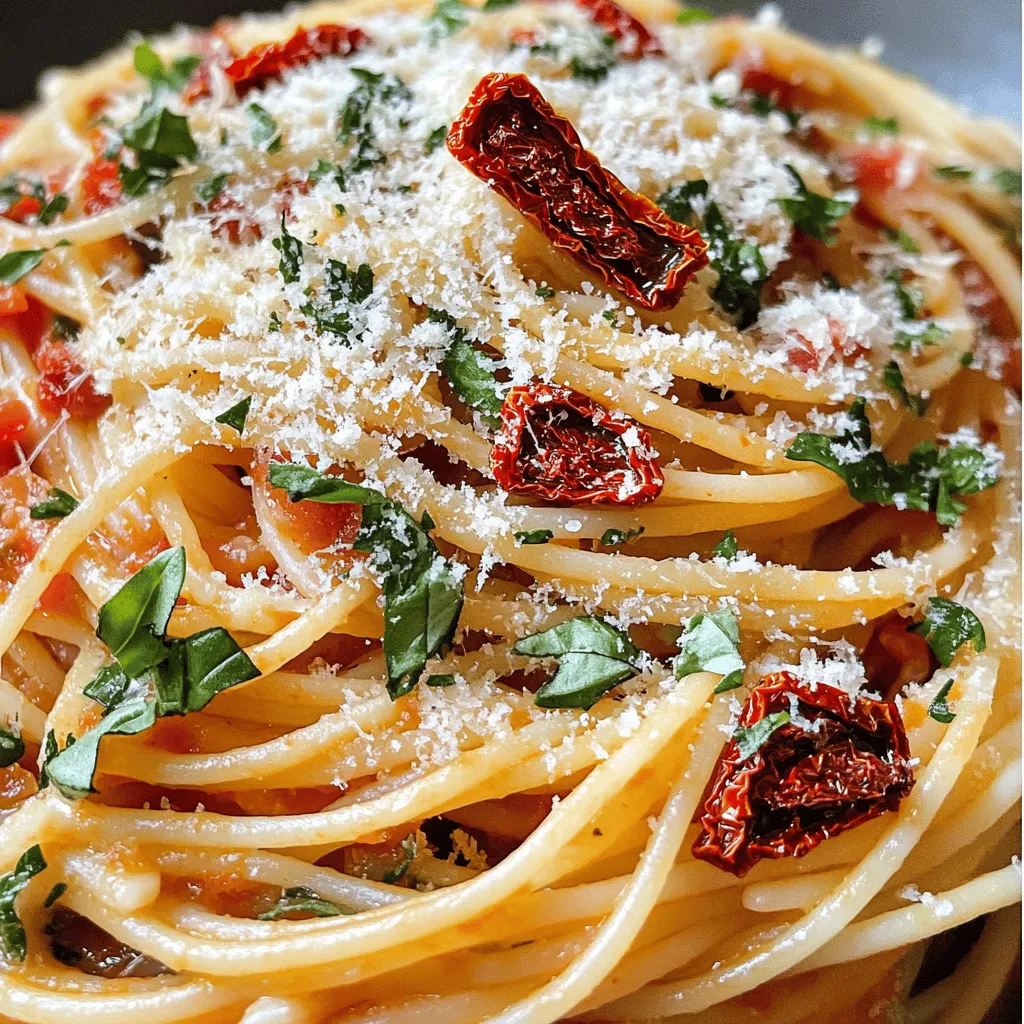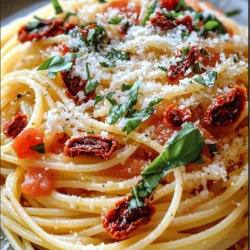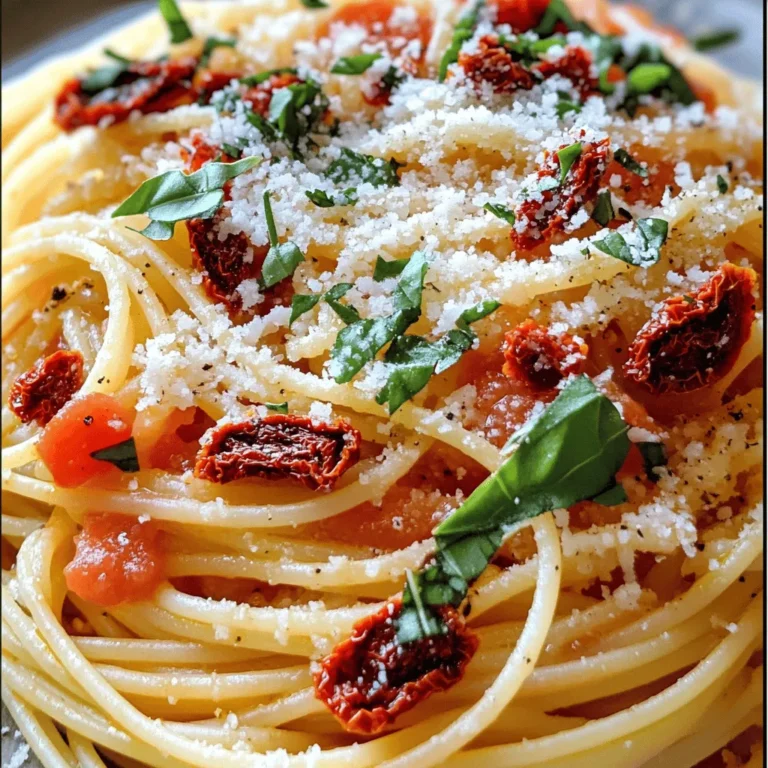Are you ready to elevate your pasta nights? My Homemade Spaghetti Sauce recipe offers rich flavor with just a few simple steps. You’ll learn what ingredients to use, how to cook perfectly, and tips for the best taste. Whether you’re a novice cook or a kitchen pro, this sauce will impress anyone at your dinner table. Let’s dive in and create something delicious together!
Ingredients
Essential Ingredients for Homemade Spaghetti Sauce
To make a great homemade spaghetti sauce, you need some key ingredients. Here’s what you should have:
– 1 tablespoon olive oil
– 1 medium onion, finely chopped
– 3 cloves garlic, minced
– 1 can (28 oz) crushed tomatoes
– 1/2 cup sun-dried tomatoes, chopped (in oil, drained)
– 1 teaspoon dried oregano
– 1 teaspoon dried basil
– 1/2 teaspoon red pepper flakes (optional, for a spicy kick)
– Salt and freshly ground black pepper, to taste
– Fresh basil leaves, for garnish
– Grated Parmesan cheese, for serving
These ingredients work together to create a rich, savory base. The olive oil adds smoothness, while the onion and garlic bring depth to the sauce.
Optional Ingredients for Customization
You can easily tweak this recipe to fit your taste. Here are some optional ingredients to consider:
– Fresh herbs like parsley or thyme
– A splash of red wine for depth
– Ground meat, like beef or turkey, for heartiness
– Other vegetables, like bell peppers or mushrooms
Feel free to experiment! Adding or swapping ingredients can create a unique flavor profile.
Nutrition Information of Key Ingredients
Understanding the nutrition of your ingredients is important. Here are some key points about the main ingredients:
– Olive oil: Contains healthy fats and antioxidants.
– Tomatoes: High in vitamins C and K, plus they provide lycopene, which is good for heart health.
– Garlic: Known for its immune-boosting properties.
– Onions: Full of vitamins and may help lower blood sugar levels.
– Parmesan cheese: Adds calcium and protein, but watch the serving size due to sodium.
Using these ingredients means you get not only great flavor but also some health benefits.
Step-by-Step Instructions
How to Make Savory Sun-Dried Tomato & Basil Spaghetti Sauce
Making this sauce is easy and fun! You start by gathering your ingredients. Here’s what you need:
– 1 tablespoon olive oil
– 1 medium onion, finely chopped
– 3 cloves garlic, minced
– 1 can (28 oz) crushed tomatoes
– 1/2 cup sun-dried tomatoes, chopped
– 1 teaspoon dried oregano
– 1 teaspoon dried basil
– 1/2 teaspoon red pepper flakes (optional)
– Salt and freshly ground black pepper, to taste
– Fresh basil leaves, for garnish
– Grated Parmesan cheese, for serving
Now, let’s cook!
1. In a large saucepan, heat the olive oil over medium heat.
2. Once hot, add the finely chopped onion. Cook for about 5-7 minutes. The onion should be soft and clear.
3. Add the minced garlic and stir for 1-2 minutes. You want it fragrant, not brown.
4. Pour in the crushed tomatoes. Mix with the onion and garlic.
5. Add the chopped sun-dried tomatoes, oregano, basil, and red pepper flakes if you like spice. Stir well.
6. Bring the sauce to a gentle boil. Once it bubbles, turn the heat to low. Cook uncovered for 25-30 minutes. Stir often so it doesn’t stick.
7. Taste the sauce. Add salt and pepper to your liking.
8. When it thickens and the flavors blend, take it off the heat.
Stovetop Cooking Method
This method is quick and gives great flavor. You can follow the steps above for the stovetop. Just keep an eye on the heat. It’s best to simmer slowly. This lets the flavors mix well.
Slow Cooker Method for Easy Preparation
Want an easier way? Use a slow cooker! Here’s how:
1. Sauté the onion and garlic in olive oil first.
2. Then, add the rest of the ingredients to the slow cooker.
3. Cook on low for 4-6 hours or high for 2-3 hours. No need to stir!
This method is great for busy days. You’ll have tasty sauce waiting for you!Enjoy your cooking!
Tips & Tricks
Perfecting the Flavor of Your Sauce
To make your sauce taste great, use fresh ingredients. Start with good olive oil. This adds depth to the flavor. Fresh garlic and onions also make a big difference. Always sauté them well to bring out their taste. For herbs, dried oregano and basil work well. You can add fresh basil at the end for more flavor. Taste your sauce as it cooks. Adjust the salt and pepper to suit your taste. If you like heat, add red pepper flakes.
Common Mistakes to Avoid
One common mistake is cooking the sauce too quickly. Let it simmer slowly for at least 25 minutes. This helps the flavors blend well. Another mistake is not tasting your sauce. Always adjust the seasoning. If your sauce is too acidic, add a pinch of sugar to balance it. Avoid overcooking the garlic, as it can turn bitter. Lastly, don’t skip the fresh basil or Parmesan cheese. They add freshness and richness.
How to Achieve the Right Consistency
For a thick sauce, let it simmer longer. Stir it often to prevent sticking. If the sauce is too thick, add a splash of water or broth. For a thinner sauce, increase the cooking time and add liquids gradually. You want a sauce that clings to the pasta without being watery. Remember, it will thicken as it cools, so keep that in mind while cooking. Enjoy making your sauce delicious and just right!

Variations
Different Herb and Spice Additions
You can change the taste of your sauce by adding herbs and spices. Try fresh parsley for a bright flavor. Rosemary adds a woodsy touch. If you like a bit of heat, add more red pepper flakes. A bay leaf during cooking gives a deep, rich note. Experiment with your favorites to find your best mix.
Meat and Protein Additions
Adding meat or protein can make your sauce heartier. Ground beef or turkey is a classic choice. You can also use Italian sausage for a spicy kick. If you prefer plant-based options, try lentils or chickpeas. They add protein without meat. Just brown the meat first before adding it to the sauce.
Alternative Bases (e.g., Vegan options)
For a vegan sauce, skip the meat and cheese. Use vegetable broth instead of water for extra flavor. You can also add pureed vegetables like carrots or mushrooms. They enhance texture and taste. For a creamy twist, stir in cashew cream or coconut milk. It gives a nice richness while keeping it plant-based.
Storage Info
Best Practices for Storing Homemade Sauce
To keep your homemade spaghetti sauce fresh, store it in a clean glass jar. Make sure the jar is dry before adding the sauce. Let the sauce cool down before sealing the jar. This helps prevent moisture build-up inside. Always label the jar with the date. Store it in the fridge for up to five days.
How to Freeze Spaghetti Sauce for Later Use
Freezing your sauce is easy and smart. First, let the sauce cool completely. Next, pour it into a freezer-safe container. Leave some space at the top for expansion. Seal the container tightly. You can freeze it for up to three months. When you’re ready to use it, just thaw it in the fridge overnight.
Reheating Tips to Maintain Quality
To reheat your sauce, pour it into a saucepan. Heat it on low to medium heat. Stir often to avoid sticking. If it seems thick, add a splash of water or broth. You can also use a microwave. Just place the sauce in a microwave-safe bowl, cover it, and heat in short bursts. Stir in between to ensure even heating. Enjoy your delicious sauce!
FAQs
Can I use fresh tomatoes instead of canned?
Yes, you can use fresh tomatoes! Use about 2-3 pounds of ripe tomatoes. First, blanch them in boiling water for one minute. Then, cool them in ice water. Peel off the skins, chop, and add them to your sauce. Fresh tomatoes bring a bright flavor to your dish. However, canned tomatoes are easier and save time.
How long does homemade spaghetti sauce last in the fridge?
Homemade spaghetti sauce lasts about 4-5 days in the fridge. Keep it in an airtight container for best results. If you want it to last longer, consider freezing it. Frozen sauce can stay fresh for up to 3 months. Just thaw it in the fridge before reheating.
What pasta dishes can I use this sauce with?
This sauce is great with many pasta dishes. You can serve it over classic spaghetti, penne, or even zoodles (zucchini noodles). It also works well in lasagna or baked pasta dishes. Feel free to get creative with your favorite pasta shapes.
What is the origin of spaghetti sauce?
Spaghetti sauce has roots in Italian cuisine. The first tomato-based sauces appeared in Italy in the 18th century. They became popular in the late 19th century. Italian immigrants brought the sauce to America. Today, it’s a beloved dish worldwide. Each region in Italy has its own unique take on this classic sauce.
Homemade spaghetti sauce is simple and fun to make. We explored key ingredients, with essential options and fun add-ins to customize your sauce. You learned cooking methods, from stovetop to slow cooker, plus tips to perfect your flavor and avoid common mistakes. We shared great variations, storage tips, and answered your most common questions.
Now, get creative in your kitchen and enjoy each delicious bite!


